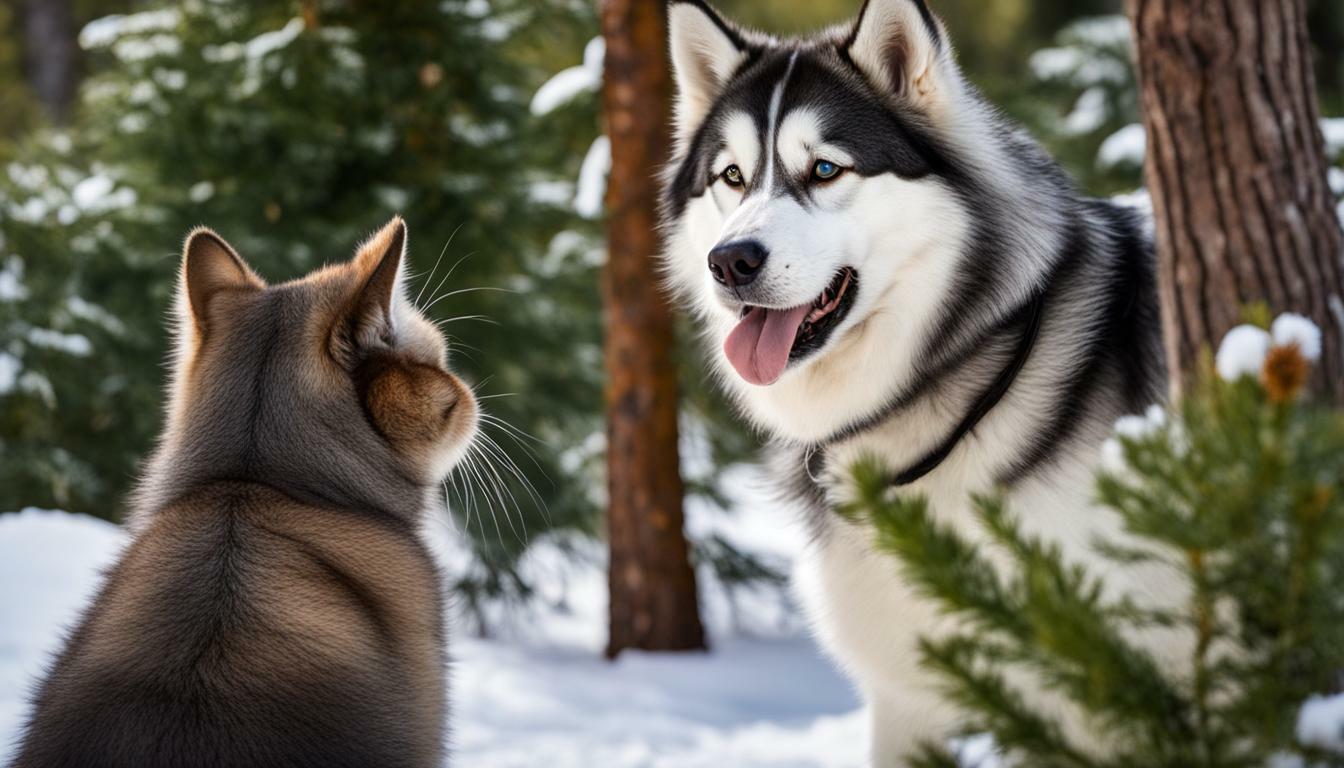When it comes to the question of whether Alaskan Malamutes are good with cats, the answer is not a simple yes or no. Alaskan Malamutes have high prey drives and can potentially chase after small animals like cats. The compatibility between Alaskan Malamutes and cats depends on several factors, including how they were introduced and at what age, as well as the individual personality of the Malamute.
Proper introduction and supervision are crucial when introducing an Alaskan Malamute to a cat. It’s important to keep them separate when unsupervised and reward the Malamute for good behavior around the cat. However, it’s worth noting that not all Alaskan Malamutes are suitable to live with cats, and some may never be able to coexist peacefully. Owners should carefully assess their individual dog’s behavior and prey drive before introducing them to a cat.
Understanding Alaskan Malamute Behavior with Cats
When it comes to the question of whether Alaskan Malamutes are good with cats, the answer is not a simple yes or no. Alaskan Malamutes have high prey drives and can potentially chase after small animals like cats. However, their compatibility with cats depends on several factors, including how they were introduced and at what age, as well as the individual personality of the Malamute.
Proper introduction and supervision are crucial when bringing a cat into an Alaskan Malamute’s environment. It’s important to start with a controlled and gradual introduction, allowing the dog and cat to become familiar with each other’s scents and presence before any physical interactions occur. This can be done by using a barrier to separate them initially, such as a baby gate or screen door.
During the introduction process, it’s essential to closely monitor the behavior of the Alaskan Malamute. Signs of aggression or excessive prey drive, such as lunging, growling, or fixating on the cat, should be addressed immediately. If necessary, seek the guidance of a professional trainer or behaviorist who can provide expert advice tailored to your specific situation.
Remember, not all Alaskan Malamutes are suitable to live with cats, and some may never be able to coexist peacefully. Each dog has its own unique personality and behavioral tendencies. Therefore, it’s crucial to carefully assess your individual dog’s behavior and prey drive before considering introducing them to a cat.
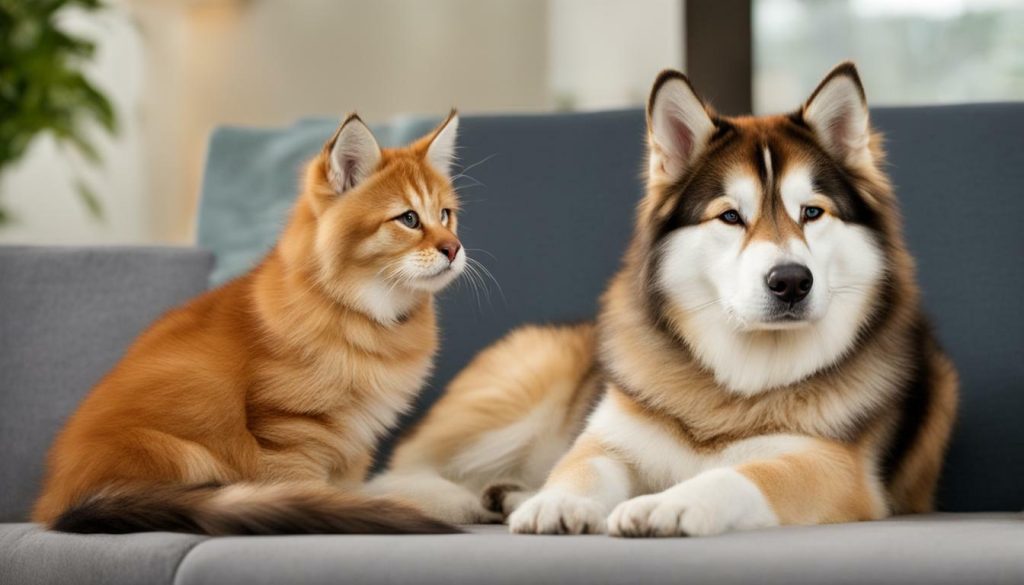
| Tip | Summary |
|---|---|
| Proper introduction | Start with a controlled and gradual introduction, allowing the dog and cat to become familiar with each other’s scents and presence before any physical interactions occur. |
| Supervision | Closely monitor the behavior of the Alaskan Malamute during the introduction process and address any signs of aggression or excessive prey drive. |
| Professional guidance | If needed, seek the advice of a professional trainer or behaviorist who can provide tailored guidance based on your specific situation. |
Introducing Alaskan Malamutes and Cats
Factual data: When it comes to the question of whether Alaskan Malamutes are good with cats, the answer is not a simple yes or no. Alaskan Malamutes have high prey drives and can potentially chase after small animals like cats. The compatibility between Alaskan Malamutes and cats depends on several factors, including how they were introduced and at what age, as well as the individual personality of the Malamute.
Proper introduction and supervision are crucial when introducing an Alaskan Malamute to a cat. It’s important to keep them separate when unsupervised and reward the Malamute for good behavior around the cat. Gradually introducing them to each other in a controlled environment can help them become familiar and comfortable with each other’s presence.
“The key to successful cat and Alaskan Malamute coexistence lies in a slow, gradual introduction,” says Dr. Sarah Thompson, a certified animal behaviorist.
“Start by keeping the cat in a separate room and allow the Malamute to sniff around the door to get accustomed to the cat’s scent. After a few days, you can swap their bedding to further familiarize them with each other’s smell. Gradually, you can start supervised interactions, always rewarding the Malamute for calm and appropriate behavior.”
In some cases, it may be necessary to consult with a professional trainer or behaviorist who has experience in introducing dogs and cats. They can provide guidance on the best techniques and strategies specific to your situation.
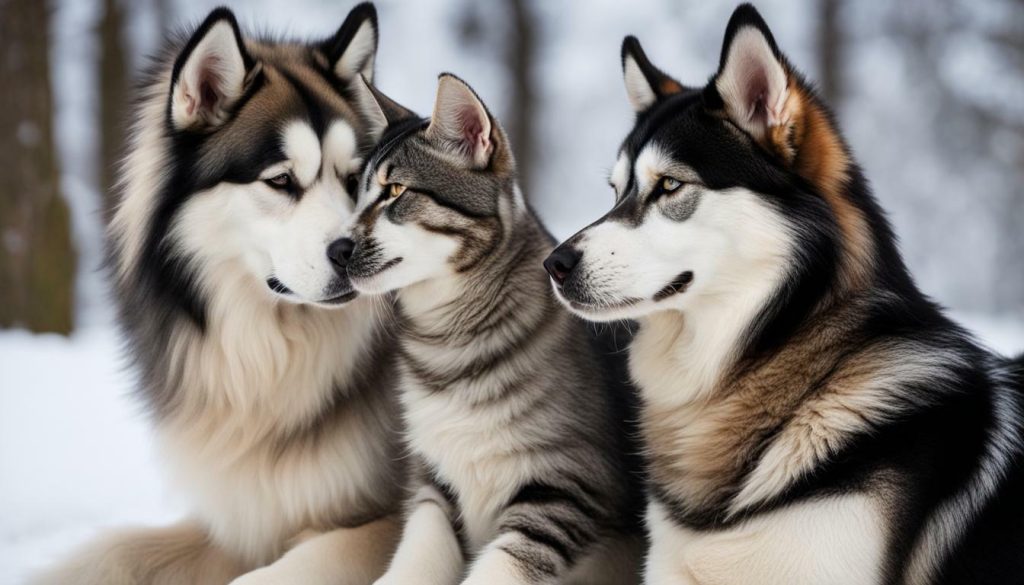
Introducing an Alaskan Malamute to a cat requires careful planning and gradual steps. It is important to acknowledge the prey drive of the Malamute and ensure proper supervision. Separating them when unsupervised and rewarding good behavior can help promote a positive relationship. Consulting a professional trainer or behaviorist can provide additional guidance and support throughout the introduction process.
Factors Affecting Compatibility
Factual data: When it comes to the question of whether Alaskan Malamutes are good with cats, the answer is not a simple yes or no. Alaskan Malamutes have high prey drives and can potentially chase after small animals like cats. The compatibility between Alaskan Malamutes and cats depends on several factors, including how they were introduced and at what age, as well as the individual personality of the Malamute. Proper introduction and supervision are crucial when introducing an Alaskan Malamute to a cat. It’s important to keep them separate when unsupervised and reward the Malamute for good behavior around the cat. However, it’s worth noting that not all Alaskan Malamutes are suitable to live with cats, and some may never be able to coexist peacefully. Owners should carefully assess their individual dog’s behavior and prey drive before introducing them to a cat.
Age
One of the key factors that can affect the compatibility between Alaskan Malamutes and cats is the age at which they are introduced. It is generally easier to introduce a puppy to a cat, as they are more open to socialization and can learn to coexist from a young age. Older Alaskan Malamutes may have established prey drive habits, making it more challenging to integrate them with a cat. Patience and careful management are essential when introducing an adult Malamute to a cat.
Individual Personality
Every Alaskan Malamute is unique, and their individual personality plays a significant role in determining their compatibility with cats. Some Malamutes may have a more docile temperament and show less interest in chasing or harming cats, while others may have a stronger prey drive. It’s important for owners to understand their dog’s personality and behavior around small animals before attempting to introduce them to a cat. This can help mitigate potential conflicts and ensure a safer and more harmonious living environment.
Prey Drive
The prey drive of Alaskan Malamutes is a natural instinct that can make them prone to chasing after small animals, including cats. While some Malamutes may be able to coexist peacefully with cats, others may have a stronger prey drive that makes it difficult for them to control their impulses. It’s crucial to assess the prey drive of an individual Malamute before introducing them to a cat. This can be done through careful observation of their behavior around small animals and consulting with experienced trainers or behaviorists. Managing and training the dog to redirect their prey drive in a positive manner can increase the chances of successful coexistence with cats.
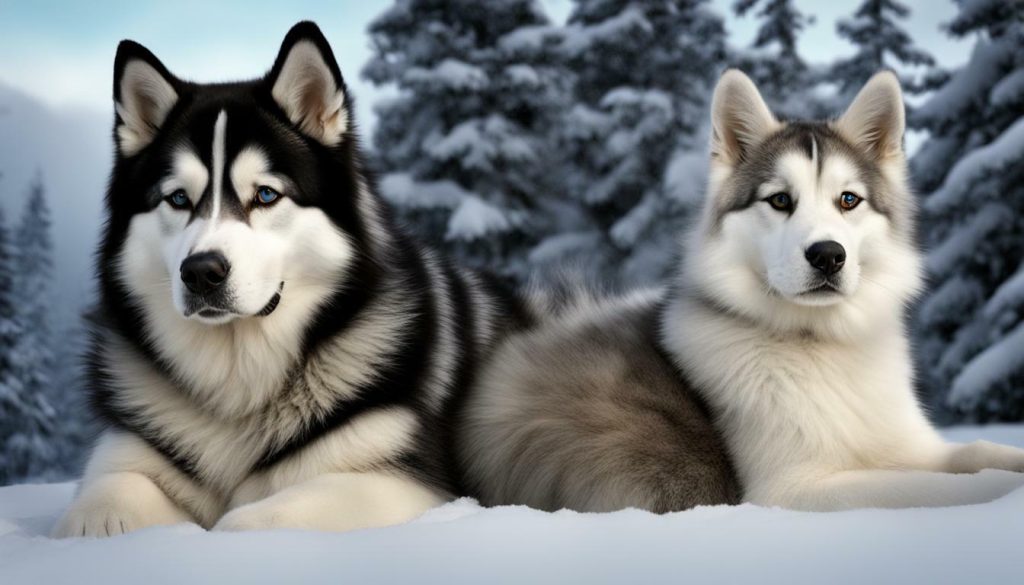
| Factors Affecting Compatibility | Summary |
|---|---|
| Age | The age at which Alaskan Malamutes and cats are introduced can impact their compatibility. It is generally easier to introduce a puppy to a cat, while older dogs may have established prey drive habits. |
| Individual Personality | The personality of the Alaskan Malamute plays a significant role in their compatibility with cats. Some dogs may have a more relaxed temperament, while others may exhibit a stronger prey drive. |
| Prey Drive | Alaskan Malamutes have a natural prey drive that can make them prone to chasing small animals. Assessing an individual dog’s prey drive is crucial in determining compatibility with cats. |
Assessing Alaskan Malamute Behavior
When it comes to introducing an Alaskan Malamute to a cat, it’s crucial to assess the behavior of your Malamute and their prey drive. Each dog is unique, and their compatibility with cats may vary. Before bringing a cat into your home, carefully observe your Alaskan Malamute’s reactions to small animals, such as squirrels or birds, to get a sense of their predatory instincts. This assessment will help you gauge their compatibility with a feline companion.
Look for signs of excitement or intense focus when your Malamute spots smaller animals. If they display a strong prey drive, it may indicate a higher risk of chasing or potentially harming a cat. On the other hand, if your Alaskan Malamute shows indifference or curiosity without excessive fixation, they may have a better chance of coexisting peacefully with a cat.
Remember, assessing behavior is just the first step. It’s crucial to proceed with caution and use proper training techniques when introducing an Alaskan Malamute to a cat. One effective strategy is to establish a controlled environment using baby gates or separate areas to ensure gradual and supervised interactions. By rewarding your Malamute for calm and respectful behavior around the cat, you can reinforce positive associations and encourage a harmonious relationship.
Assessing your Alaskan Malamute’s behavior and prey drive is essential before introducing them to a cat. It helps determine their compatibility and guides the necessary precautions for a successful integration.
Table 1: Assessing Alaskan Malamute Behavior
| Behavior | Potential Implications |
|---|---|
| Intense focus and excitement towards small animals | Possibility of chasing or harming a cat |
| Indifference or curiosity without fixation | Higher chance of peaceful coexistence with a cat |
By carefully assessing your Alaskan Malamute’s behavior, you can make informed decisions about introducing them to a cat. Remember, not all dogs are suited to live with feline companions, and it’s important to prioritize the safety and well-being of both animals. Seeking guidance from experienced trainers or behaviorists can provide additional support and expertise throughout the process of introducing an Alaskan Malamute and a cat.
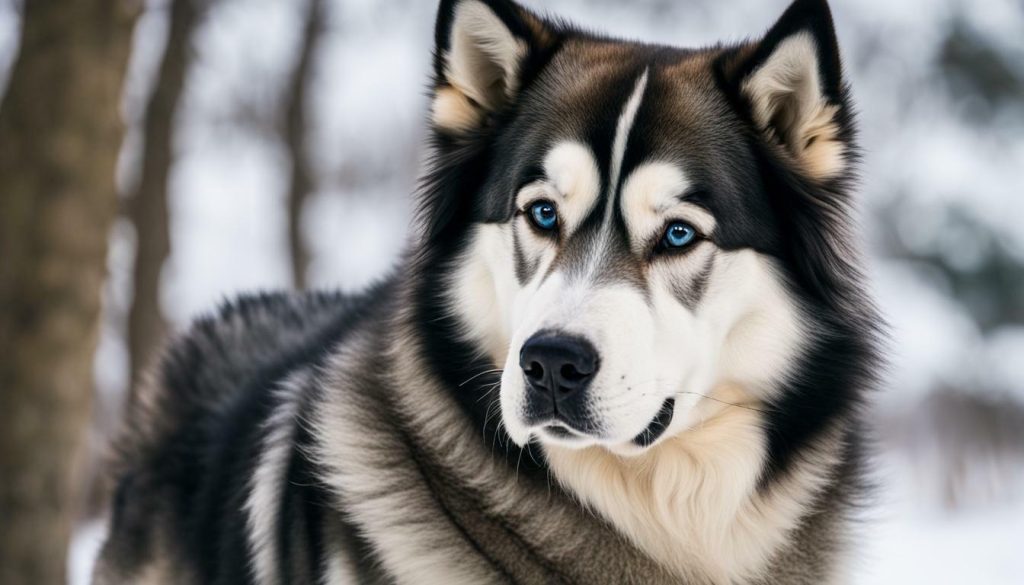
With a thorough assessment of your Alaskan Malamute’s behavior and proper introduction techniques, you can create a harmonious environment for both your dog and a cat. While challenges may arise, consistent training, management of prey drive, and patience can help foster a successful coexistence. Remember, every dog-cat dynamic is unique, and it’s essential to prioritize the individual needs and personalities of both animals.
References:
- “Introducing Dogs and Cats” – American Society for the Prevention of Cruelty to Animals (ASPCA)
- “Can Dogs and Cats Live Together Peacefully?” – The Humane Society of the United States (HSUS)
- “Introducing a New Cat to a Resident Dog” – International Cat Care (ICC)
Tips for Successful Coexistence
7. When it comes to living harmoniously with your Alaskan Malamute and cat, there are several tips that can help ensure a successful coexistence. First and foremost, it is essential to provide separate spaces for your pets. This allows them to have their own territories and reduces the chances of any confrontations or conflicts. Create designated areas for your Malamute and your cat, complete with comfortable bedding, toys, and food and water dishes.
8. Positive reinforcement training is another crucial aspect of successful coexistence. Reward your Alaskan Malamute for good behavior around the cat, such as remaining calm and not displaying any signs of aggression. Use treats, praise, and playtime to reinforce positive behavior and help your dog associate the presence of the cat with positive experiences.
9. Gradual integration is key when introducing an Alaskan Malamute to a cat. Start by allowing them to sniff each other’s scents through closed doors or gates. Slowly progress to supervised, controlled interactions, keeping them both on a leash or harness to maintain control. Gradually increase the duration and frequency of their interactions as long as they remain calm and comfortable in each other’s presence.
| Tip | Explanation |
|---|---|
| Provide separate spaces | Creating designated areas for your Alaskan Malamute and cat helps them establish their territories and reduces the chances of conflict. |
| Use positive reinforcement training | Rewarding your Alaskan Malamute for good behavior around the cat helps them associate positive experiences with each other. |
| Gradually integrate them | Start with sniffing each other’s scents and progress to supervised interactions, gradually increasing duration and frequency. |
The Importance of Consistency
Consistency in training and management is crucial when it comes to the coexistence of Alaskan Malamutes and cats. Enforce the same rules and boundaries for both pets to establish a fair and balanced environment. This consistency will help your Alaskan Malamute understand what is expected of them and ensure a smoother integration with your cat.
Remember, every Alaskan Malamute is unique, and their compatibility with cats can vary. Some Malamutes may never be completely comfortable living with cats, despite your best efforts. It is crucial to carefully assess your dog’s behavior and prey drive before introducing them to a cat. Seeking professional help from experienced trainers or behaviorists can provide additional guidance and support throughout the process.
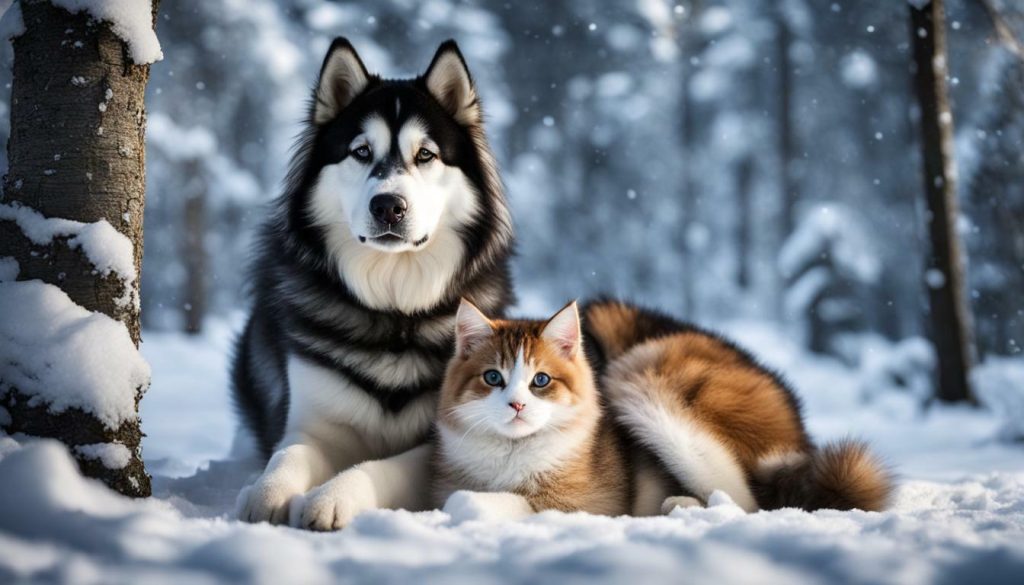
Successful coexistence between Alaskan Malamutes and cats requires careful consideration, proper introduction, supervision, and management. Providing separate spaces, using positive reinforcement training, and gradually integrating them can contribute to a harmonious environment. However, it’s important to remember that not all Alaskan Malamutes will be compatible with cats, and seeking professional help may be necessary. By following these tips and understanding the unique dynamics between your pet and your cat, you can increase the chances of a successful and peaceful coexistence.
The Potential Challenges
When considering the coexistence of Alaskan Malamutes and cats, there are several potential challenges that owners should be aware of. Due to their high prey drives, Malamutes may view cats as small animals to chase after. This natural instinct can pose a challenge when trying to introduce them to a cat, as the Malamute may display predatory behavior. Proper management and training are essential to mitigate these potential challenges.
One potential challenge is the initial introduction between an Alaskan Malamute and a cat. It is crucial to carefully plan and control this process to ensure the safety and well-being of both animals. Gradual and controlled introductions, with the use of barriers such as baby gates or crates, can help the Malamute and cat become familiar with each other’s presence without direct contact. This allows them to slowly acclimate to one another’s scent and behavior.
Another challenge is managing the prey drive of the Alaskan Malamute. It’s important to remember that this drive is inherent to the breed and cannot be completely eliminated. Owners should always supervise interactions between the Malamute and cat, and be prepared to intervene if necessary. Providing the Malamute with regular exercise and mental stimulation can help redirect their energy away from chasing the cat.
It’s essential to be realistic about the potential outcomes when attempting to have an Alaskan Malamute and a cat live together. While some Malamutes may be able to coexist peacefully with cats, others may never be able to overcome their prey drive. Each dog is an individual, and their behavior should be carefully assessed before introducing them to a cat. Seeking professional help and resources, such as experienced trainers or behaviorists, can provide valuable guidance throughout the process.
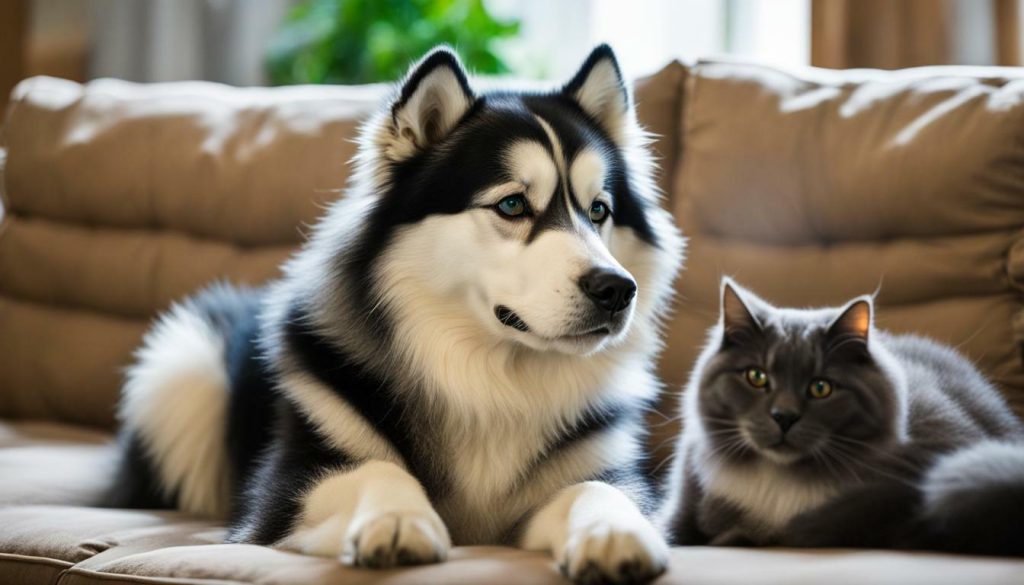
This table provides a summary of the potential challenges when attempting to have Alaskan Malamutes and cats live together:
| Challenge | Management Strategy |
|---|---|
| High prey drive | Supervision, redirection, and exercise |
| Initial introduction | Gradual and controlled introductions with barriers |
| Managing predatory behavior | Supervision and redirecting focus |
| Realistic expectations | Careful assessment and seeking professional help |
Professional Help and Resources
If you’re considering introducing an Alaskan Malamute to your cat or if you’re already facing challenges with their coexistence, seeking professional help can make a significant difference. Experienced trainers or behaviorists can provide guidance tailored to your specific situation, offering insights and strategies to ensure a harmonious living environment for both your dog and cat.
Professional help can assist you in understanding the behavior of Alaskan Malamutes and provide training techniques that promote positive interaction between dogs and cats. They can help you assess your dog’s prey drive and behavior to determine the feasibility of coexistence.
Additionally, resources such as books, online forums, and articles can provide valuable information on cat socialization with Alaskan Malamutes. These resources can give you further insights into successful introductions, training methods, and real-life experiences from other pet owners who have faced similar challenges.
Remember, seeking professional help and utilizing available resources can greatly increase the chances of a successful and peaceful coexistence between your Alaskan Malamute and cat.
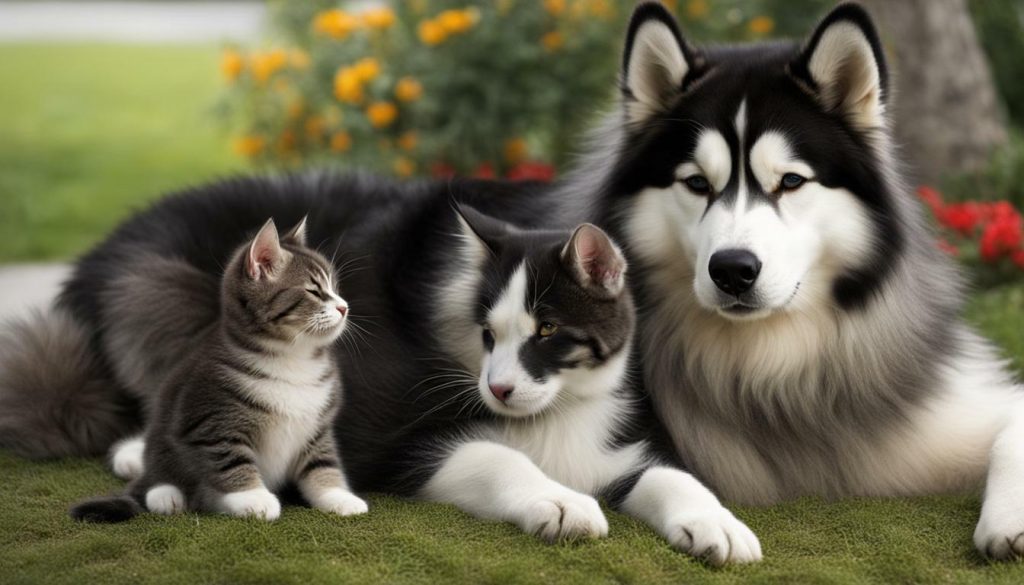
| Resource | Description |
|---|---|
| Book: “Introducing Alaskan Malamutes and Cats” | This comprehensive guide provides step-by-step instructions and professional advice on introducing Alaskan Malamutes and cats, covering common challenges and effective training techniques. |
| Online Forum: “Malamute Meets Cat” | Join this active online community where Alaskan Malamute and cat owners share their experiences, ask questions, and receive support from like-minded individuals. |
| Article: “Successful Alaskan Malamute and Cat Coexistence” | This informative article offers practical tips and insights into creating a harmonious living environment for Alaskan Malamutes and cats, focusing on key factors and strategies for success. |
Conclusion
When it comes to the question of whether Alaskan Malamutes are good with cats, the answer is not a simple yes or no. Alaskan Malamutes have high prey drives and can potentially chase after small animals like cats. The compatibility between Alaskan Malamutes and cats depends on several factors, including how they were introduced and at what age, as well as the individual personality of the Malamute.
Proper introduction and supervision are crucial when introducing an Alaskan Malamute to a cat. It’s important to keep them separate when unsupervised and reward the Malamute for good behavior around the cat. However, it’s worth noting that not all Alaskan Malamutes are suitable to live with cats, and some may never be able to coexist peacefully.
Owners should carefully assess their individual dog’s behavior and prey drive before introducing them to a cat. Consulting with experienced trainers or behaviorists can provide helpful guidance and resources for Alaskan Malamute and cat socialization. By following these steps, you can increase the chances of successful coexistence between Alaskan Malamutes and cats, creating a harmonious and safe environment for both pets.
FAQ
Q: Are Alaskan Malamutes good with cats?
A: The answer is not a simple yes or no. Alaskan Malamutes have high prey drives and can potentially chase after small animals like cats. Compatibility between Alaskan Malamutes and cats depends on several factors, including how they were introduced and at what age, as well as the individual personality of the Malamute.
Q: What should I consider when introducing an Alaskan Malamute and a cat?
A: Proper introduction and supervision are crucial when bringing an Alaskan Malamute and a cat together. It’s important to keep them separate when unsupervised and reward the Malamute for good behavior around the cat. However, it’s worth noting that not all Alaskan Malamutes are suitable to live with cats, and some may never be able to coexist peacefully.
Q: How can I assess my Alaskan Malamute’s behavior towards cats?
A: Owners should carefully assess their individual dog’s behavior and prey drive before introducing them to a cat. Observing their reaction to other small animals and consulting with experienced trainers or behaviorists can provide valuable insights.
Q: What are some tips for successful coexistence between Alaskan Malamutes and cats?
A: Providing separate spaces, positive reinforcement training, and gradual integration are important strategies for successful coexistence. It’s crucial to create a positive and controlled environment for both the dog and the cat.
Q: What are the potential challenges of having an Alaskan Malamute and a cat together?
A: The challenges may include managing the prey drive of the Malamute, consistent training, and the possibility that some dogs may never be able to peacefully coexist with cats. Ongoing supervision and management are necessary to ensure the safety of both pets.
Q: Should I seek professional help for socializing an Alaskan Malamute and a cat?
A: Consulting with experienced trainers or behaviorists can provide valuable guidance and resources for successfully socializing an Alaskan Malamute and a cat. They can assess the behavior of both pets and provide personalized advice.
